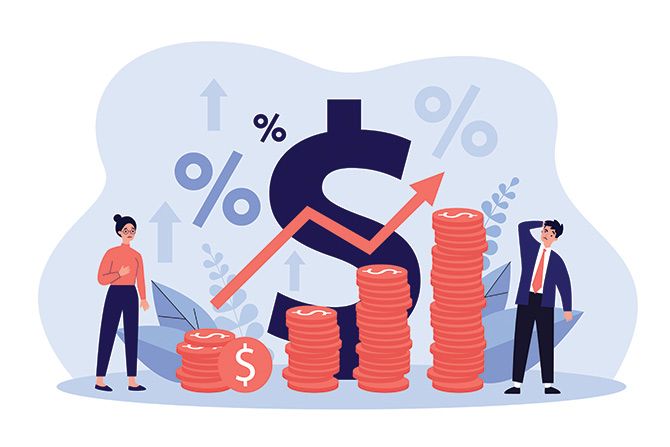I wrote a bit about inflation this year, as it was a burgeoning problem beginning to pick up steam in the national dialogue, but now might be an appropriate time to return to the topic. Inflation has now become the topic du jour in national economic discourse, with pundits both expressing the need to bring it down and searching for the possible instigators. Let’s examine how the topic has continued to evolve in recent months, inflation’s origins and effects, and also how instructive it is to study the way it is discussed in much of our media.
A theme that often emerges when paying attention to American media discourse is blame obfuscation. Problems don’t emerge from thin air, they’re caused by specific courses of action and discreet decisions often made by powerful interests, but much of our media discourse seems to exist to muddy this fact. A quick examination of the recent discourse around inflation shows how much of it is meant to leave the viewer or reader in a state of befuddlement rather than enlightenment. It wouldn’t be a stretch to say that one of the overriding missions of our media, whether conscious or unconscious, is to take problems that have real, tangible origins and to declare that the origins of such problems are impenetrably complicated and not even worth delving into for fear of getting lost in complex minutiae.
In reality, this posture of impenetrable complexity belies the fact that our media doesn’t want to find out the answers, so shrouding everything in a web of mysticism and opacity serves a purpose. Notably, prominent economic figures such as former Treasury Secretary Larry Summers and current Federal Reserve Chair Jerome Powell have stated recently that they believe the quickest way to curb inflation is to raise unemployment by nearly 2%, meaning approximately 10 million Americans would lose jobs. If you’ll recall, the talk in elite economic circles only a year ago was that nobody wanted to work anymore and filling low-wage jobs was becoming an impossibility. Now, those same economists are casually suggesting kicking millions of Americans out of their current jobs. If you notice a pattern, it’s that workers are to be manipulated like puppets depending on what the economic conditions call for and that no underlying economic principles seem to exist.
The problem with the notion that inflation is being created largely by sky-high employment and increasing wages is that it’s mostly untrue. But the most powerful factions of our society tend to work backward from their conclusions and they want it to be the case that inflation is being caused by better worker conditions. According to a recent paper by the Economic Policy Institute (EPI), the answer to the inflationary cycle largely lies in places the most powerful people in society don’t really care to look, most notably the corporate sector. As the EPI paper details, “The price of just about everything in the U.S. economy can be broken down into the three main components of cost. These include labor costs, nonlabor inputs, and the “mark-up” of profits over the first two components. Good data on these separate cost components exist for the nonfinancial corporate (NFC) sector — those companies that produce goods and services — of the economy, which makes up roughly 75% of the entire private sector. Since the trough of the COVID-19 recession in the second quarter of 2020, overall prices in the NFC sector have risen at an annualized rate of 6.1%—a pronounced acceleration over the 1.8% price growth that characterized the pre-pandemic business cycle of 2007–2019. Strikingly, over half of this increase (53.9%) can be attributed to fatter profit margins, with labor costs contributing less than 8% of this increase. This is not normal. From 1979 to 2019, profits only contributed about 11% to price growth and labor costs over 60%. Nonlabor inputs — a decent indicator for supply-chain snarls — are also driving up prices more than usual in the current economic recovery.”
This flies in the face of the belief among the most powerful factions in society, that inflation is due to workers simply living too high on the hog, making too much money, and, ultimately, having too much purchasing power. As the EPI paper further elucidates, “The historically high-profit margins in the economic recovery from the pandemic sit very uneasily with explanations of recent inflation based purely on macroeconomic overheating. Evidence from the past 40 years suggests strongly that profit margins should shrink and the share of corporate sector income going to labor compensation (or the labor share of income) should rise as unemployment falls and the economy heats up. The fact that the exact opposite pattern has happened so far in the recovery should cast much doubt on inflation expectations rooted simply in claims of macroeconomic overheating.”
In the past, when economists talk of “overheating,” it generally refers to labor or the consumer gaining too much power, specifically in relation to factors like rising real wages and a rising labor share of the income. This dynamic is usually characterized by falling unemployment leading to increased bargaining power for workers that in turn leads to real wage growth threatening to outpace economy-wide productivity growth. The fear here is a potential wage-price spiral, where employers have to raise prices to meet workers’ wage demands, and workers demand pay increases to protect them from rising prices. In this type of economic scenario, there are usually calls for the Federal Reserve to raise interest rates sharply. This has been economic conventional wisdom through the decades.
However, as the EPI paper details, the traditional indicators of economic overheating are not necessarily appearing at this present moment. “Currently, the labor share of income and real wages are falling sharply in the recovery even as unemployment falls. It seems strange to see a pattern in the data that is the complete opposite of how overheating-driven inflation has historically worked and not ask if it might be something different this time causing inflation (i.e., the pandemic). Many of those most dismissive of claims that increased corporate power has driven recent inflation to adopt the view that generalized macroeconomic overheating is the culprit. But in dismissing the increased corporate power explanation for recent inflation, they also seem to be discarding any useful information that recent sky-high profit margins might provide about the validity of their alternative view. Profit margins may not be telling us that very recent increases in corporate power are the root cause of inflation. But they are telling us that a simple macroeconomic imbalance of supply and demand is not driving inflation either, unless the relationship between a “hot” economy and profit margins and real wages is just coincidentally behaving entirely differently in the current recovery than it has in the past.”
A simple trick when evaluating economic woes is to think about who has all the power in terms of setting prices, setting working conditions, wages, etc. In our economic system, it’s almost always the employers. However, it’s often presented by the media as if this power dynamic is in dispute; as if it’s difficult to determine who is really wielding power. What is even more alarming is that those closest to the centers of power, such as Larry Summers and Jerome Powell, don’t seem to want to search for the correct answers. Their one answer is to discipline labor, even when that well has run dry. There are measures that can be taken to tackle corporate-driven inflation, such as an excess profits tax. But those in power must want to do that and, at an even more basic level, recognize the nature of the problem. As with many problems in our society, there are solutions that are tantalizingly close but often seem impossibly far away.









